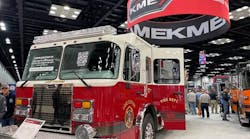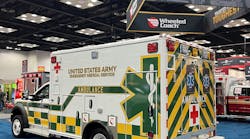The first point that must be made is that a fire apparatus will travel a great distance from the point where the operator first realizes the need to stop and where the fire apparatus actually comes to a complete stop. The first part of that distance traveled is referred to as the "perception distance" the distance your apparatus travels from the time you spot a problem until you decide what corrective action to take. Another way to describe this is as the distance the apparatus will travel from the time your eyes spot a problem until your brain receives this signal, processes the information and then makes a decision on what action or actions to take.
The next part of that distance traveled is referred to as "reaction distance," or the distance your apparatus will travel while you move your foot from the accelerator to the brake pedal. This distance can be substantially reduced if the operator puts his or her foot over the brake at the first sign of a potential problem. This is also called "covering the brake."
If the operator covers the brake, the vehicle can save 1.1 feet for every mile per hour of speed. For example, if the fire apparatus is traveling at 50 mph and the driver covers the brake as danger is perceived ahead, the fire apparatus will save 55 feet (50 mph x 1.1 feet = 55 feet). The distance saved by covering the brake could be the difference between having and not having an accident.
If your apparatus is equipped with auxiliary braking devices, you will stop even sooner, as many of these devices are activated when you lift your foot off the accelerator. The time it takes for the operator to move his or her foot to the brake from the accelerator is the driver's reaction time. The average driver's reaction time is three-quarters of a second. However, if the driver is drunk, on drugs, fatigued or has aged to the point that hearing, eyesight or reflexes are affected, the reaction time is going to be substantially longer. Accident investigation experts have said that at night the average driver's reaction time could be as much as 1 3/4 seconds.
The next distance traveled is "brake lag distance"; that is the distance the apparatus travels after you apply the brakes and before they actuate. Brake lag distance is applicable only for vehicles equipped with air brakes. If you have a vehicle equipped with hydraulic-type brakes, there is no brake lag because depressing the brake pedal compresses a liquid that has an instantaneous reaction on the brakes. Air brakes are extremely reliable and completely safe. However, when the brake pedal is depressed in a vehicle equipped with air brakes, there is a momentary delay. This delay occurs when the brake pedal is depressed. It then triggers a release of air from the air-holding tanks, which in turn travels through the brake lines and actuates the brakes.
The last distance we travel is the "braking distance" the distance your apparatus travels after the brakes take hold until the apparatus comes to a complete stop.
By adding all the distances together you have the "total stopping distance." The equation looks like this:
+ REACTION DISTANCE
+ BRAKE LAG DISTANCE
+ BRAKING DISTANCE
= TOTAL STOPPING DISTANCE
Although this is the standard formula for computing stopping distances, many other factors can affect how long it will take to bring your fire apparatus to a complete and safe stop:
- Brake fade. When there are multiple brake applications in a short period of time, particularly when the vehicle involved is carrying a lot of weight going down a steep grade, the brakes overheat. As the brakes overheat, they are said to be glazed over, which reduces friction; this in turn will cause the brakes to fail.
- Speed. The faster the apparatus is moving, the longer it takes to stop the apparatus.
- Weight. Too much weight could cause the weight to overrun the brakes (brake fade) and could cause brake failure. Not enough weight; driving a tractor-trailer combination without the trailer (bobtailing). Many tractor-trailer drivers who have had to bobtail a tractor will be able to tell you about harrowing experiences, this writer included.
- The forward surge of the water in your tanks. With water weighing eight-plus pounds per gallon and with most tank sizes ranging from 1,000 to 4,000 gallons, one would only have to do the calculations to realize that we are trying to stop 8,000 to 32,000 pounds of water weight in motion. This water weight in motion is not only front to back but also side to side.
- Hills. It takes longer to stop going down a hill then it does to stop going uphill or on level pavement. Forward momentum and gravity.
- Wet or slippery surfaces. Driving in any kind of inclement weather will affect your ability to stop. One good example that comes to mind for this time of year is driving on wet leaves. It's like driving on ice.
- Type of road surface. It takes a greater distance to stop on gravel, dirt or a sandy surface than it does to stop on concrete or blacktop. I recall in accident investigation and reconstruction classes at which much time was spent describing the coefficient of friction for each surface and how it affects a vehicle's ability to stop.
- Condition of brakes and tires. New brakes and new tires mean less distance it takes to stop. Worn brakes and worn tires mean more distance it takes to stop.
- The driver. A driver who is drunk, on drugs, fatigued, lacks good reflexes, has a poor attitude or has a lack of experience will affect stopping distances.
There are some braking tips that can be offered here: slower is safer. You must control the apparatus, don't let the apparatus control you. All apparatus must be kept in top shape. Train your drivers so that they may handle specific traffic situations, such as hills, different road surfaces, slippery road surfaces or any other situations specific to your jurisdiction.
The next column will discuss auxiliary braking devices.
The staff of Firehouse® and I take great pride in the very sensitive way in which we select photos and stories for this column. As I have written in this column and said at many classes that I have taught, we do use photos and accident accounts but their use is not intended to demean any department or any person. We use this material to educate ourselves in the hope that a type of accident will not happen again or to save firefighters' lives.
We take extreme measures to use material that does not identify a department by name. For every photo we use in this column, we reject many others because a department's name or apparatus numbers are visible. I recently received a letter that suggested that we have a hidden political agenda. Nothing could be further from the truth. The only reason I write this column is to educate firefighters and to save firefighters' lives.
Michael Wilbur, a Firehouse® contributing editor, is an FDNY lieutenant in Ladder Company 27 in the Bronx and a firefighter in the Howells, NY, Fire Department. He is an adjunct instructor at the New York State Academy of Fire Science and the Orange County Fire Training Center. Wilbur has developed and presented emergency vehicle operator courses throughout the country and has consulted on a variety of fire apparatus issues.




